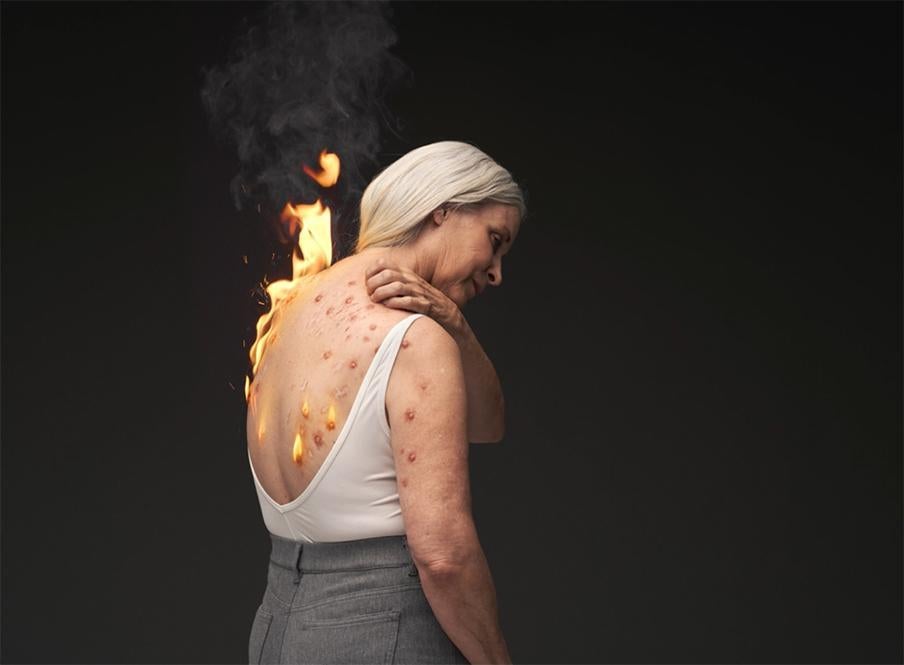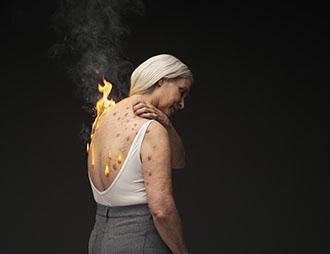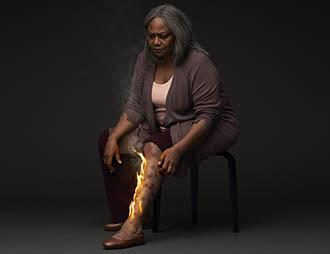Diagnosing Prurigo Nodularis
The signs and symptoms
PN has a characteristic appearance on morphology. When examining patients, the signs and symptoms of PN to look out for are1,2:
Essential
(core symptoms)
- The presence of firm, nodular lesions1,2
- Pruritus lasting ≥6 weeks.2
- A history and/or signs of repeated scratching, picking, or rubbing (eg, excoriations and scars).1,2
Important
(common additional features)
- A symmetrical distribution of lesions on areas of skin that are accessible to scratching (rarely found on the face, palms, soles, scalp, or genitals).1,2
- The presence of additional lesions induced by scratching, picking, or rubbing (eg, lichenified plaques, excoriations, ulcerations, and/or scars).1,2
- Pruritus that is accompanied by burning, stinging, pain, and/or other sensations.1,2
Associated
(common additional features)
- Burden of disease, such as impaired quality of life, sleep deprivation, missed work and/or school, emotional impact (eg, depression, anxiety, anger, shame, helplessness), and social isolation.1,2
- Systemic comorbidities, such as impaired liver, renal, or thyroid function, diabetes, HIV infection, hepatitis B/C, and malignancy.1,2
Differentiating PN from AD
PN presents with an often symmetrical distribution of firm, nodular lesions while AD presents with an often diffuse distribution of eczematous lesions.1,2



Laboratory assessment for PN
Initial laboratory assessment for all patients suspected of having PN should include2:
- A complete blood cell count with differential.2
- Hepatic and renal function tests.2
Recognising PN in Patients of Colour
It is important to remember that the signs and symptoms of PN may vary from patient to patient.3 Postinflammatory dyspigmentation, including hyperpigmentation and hypopigmentation, is more common in patients with skin of color.4
The Burden of PN is Oppressive
PN severely impacts many aspects of patients’ lives.5 A study has shown that patients with PN experience a higher burden of disease than patients with several other chronic pruritic skin diseases. The study also showed that pruritus in PN was more severe than that of the other skin diseases.6
Things to Note
Although PN can be associated with AD, most patients with PN do not have a history of AD.7-9
- Elmariah S, Kim B, Berger T, et al. Practical approaches for diagnosis and management of prurigo nodularis: United States expert panel consensus. J Am Acad Dermatol. 2021;84(3):747-760. doi:10.1016/j.jaad.2020.07.025
- Ständer S, Pereira MP, Berger T, et al. IFSI-guideline on chronic prurigo including prurigo nodularis. Itch. 2020;5(4):e42. doi:10.1097/itx.0000000000000042
- Huang AH, Williams KA, Kwatra SG. Prurigo nodularis: epidemiology and clinical features. J Am Acad Dermatol. 2020;83(6):1559-1565. doi:10.1016/j.jaad.2020.04.183
- Davis EC, Callender VD. Postinflammatory hyperpigmentation: a review of the epidemiology, clinical features, and treatment options in skin of color. J Clin Aesthet Dermatol. 2010;3(7):20-31
- Janmohamed SR, Gwillim EC, Yousaf M, Patel KR, Silverberg JI. The impact of prurigo nodularis on quality of life: a systematic review and meta-analysis. Arch Dermatol Res. 2021;313(8):669-677. doi:10.1007/s00403-020-02148-0
- Steinke S, Zeidler C, Riepe C, et al. Humanistic burden of chronic pruritus in patients with inflammatory dermatoses: results of the European Academy of Dermatology and Venereology Network on Assessment of Severity and Burden of Pruritus (PruNet) cross-sectional trial. J Am Acad Dermatol. 2018;79(3):457-463.e5. doi:10.1016/j.jaad.2018.04.044
- Huang AH, Canner JK, Khanna R, Kang S, Kwatra SG. Real-world prevalence of prurigo nodularis and burden of associated diseases. J Invest Dermatol. 2020;140(2):480-483.e4. doi:10.1016/j.jid.2019.07.697
- Pereira MP, Hoffmann V, Weisshaar E, et al. Chronic nodular prurigo: clinical profile and burden. A European cross-sectional study. J Eur Acad Dermatol Venereol. 2020;34(10):2373-2383. doi:10.1111/jdv.16309
- Kwon CD, Khanna R, Williams KA, Kwatra MM, Kwatra SG. Diagnostic workup and evaluation of patients with prurigo nodularis. Medicines (Basel). 2019;6(4):97. doi:10.3390/medicines6040097
References



